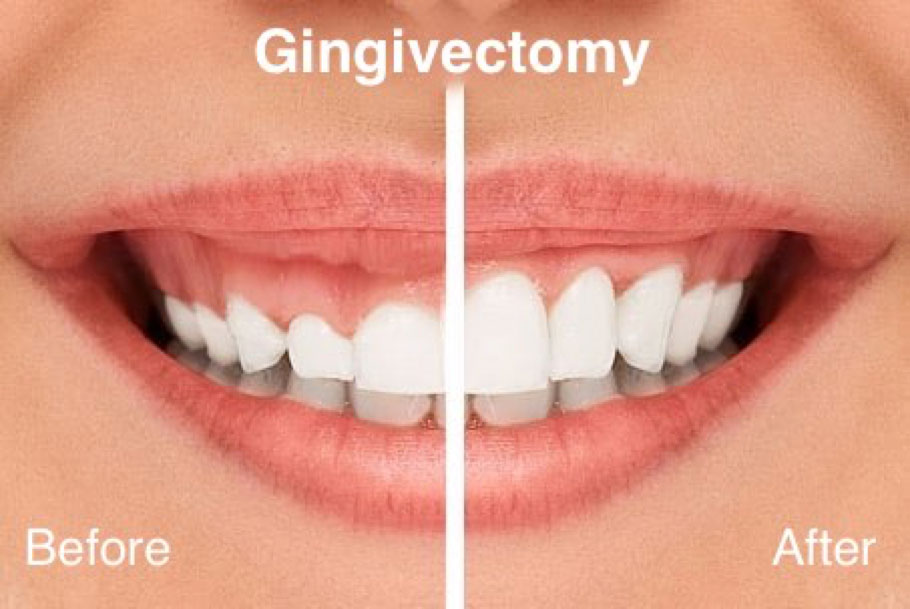Unfortunately, gums affected by Periodontal Disease don’t reattach to teeth on their own. When pockets develop, gum surgery is often necessary to correct the problem.
A gingivectomy is a surgical gum disease treatment used to remove diseased gum tissue, helping to reduce pockets and slow down the progression of gum disease.
The Gingivectomy Procedure
While your emergency dentist may perform your gingivectomy procedure, it is usually done by oral surgeon. Prior to the gingivectomy procedure, scaling and root planning is often used to remove bacteria and tartar from below the gum line. The gingivectomy procedure itself typically requires just local anesthesia to numb your gums. Traditionally, a scalpel is used to remove gum tissue, but today, many dentists use laser gingivectomy for less invasive treatment, minimized bleeding and faster healing time. (It’s important to note that the gingivectomy cost may range according to the type of gingivectomy procedure performed.) Depending on how much tissue needs to be removed, the gingivectomy procedure can take anywhere from a few minutes to an hour.
Following your gingivectomy procedure, a periodontal dressing will be placed over your gums to protect them while they heal, which stays on for an average of seven to 10 days. During this time, it’s important that you follow your dentist’s post-surgery guidelines so as to not accidentally remove the dressing or damage your gums. You will most likely only be able to eat soft foods and drink liquids while the dressing is in place. While you can continue practicing your oral hygiene regimen, you should avoid brushing near the surgical area until your dentist tells you it’s safe to do so. It may take several weeks for your gums to appear normal again and up to three months for your gums to heal completely.
Does a Gingivectomy Hurt?
Most periodontic procedures aren’t painful, but you may feel some discomfort following your gingivectomy procedure. Bleeding gums are also normal for the first day or two. As with any surgical procedure, there is always a minor risk of infection. Your dentist may prescribe you antibiotics to reduce your risk of infection from bacteria entering the bloodstream.
While the majority of gingivectomy procedures are successful, you should contact your dentist if you notice any of the following:
- Signs of infection, swelling or puss around the treated area
- Prolonged bleeding
- Excessive pain
- The periodontal dressing becomes dislodged early
Remember, the goal of a gingivectomy or laser gingivectomy procedure is to stop gum disease from progressing. You’ll need to take care of your gums following your procedure in order for the results to remain effective — that includes practicing good oral hygiene, making healthy food choices and visiting your dentist regularly. Smoking should also be avoided, as it can greatly damage your periodontal tissue and even reverse the effects of your gingivectomy procedure.
One Surgery, Multiple Uses
While originally developed primarily to treat gum disease, today’s gingivectomy procedure now has several other purposes. A gingivectomy can be used as a preventive measure to remove excess gum tissue, making it easier to keep your teeth clean. A gingivectomy is now often combined with a gingivoplasty, a procedure used to reshape uneven gums. With the popularity of cosmetic dentistry increasing, these procedures are now commonly used for aesthetic purposes — for instance, to correct a “gummy smile.”
Gingivectomy Cost
The cost of gingivectomy will vary according to how much diseased tissue needs to be removed, your dentist’s experience and the type of gingivectomy procedure used. A laser gingivectomy may differ in price from a traditional gingivectomy procedure. It’s important to ask your dentist about the cost of gingivectomy prior to your procedure. If you have dental insurance, find out what’s covered and how much of the gingivectomy cost is your responsibility.
If you have gum disease, ask your dentist whether a gingivectomy; or laser gingivectomy is right for you. With the right gum disease treatment, you could maintain a healthy smile and keep your teeth for life!

